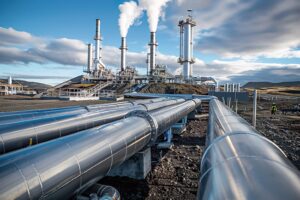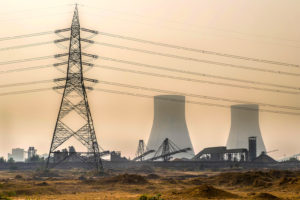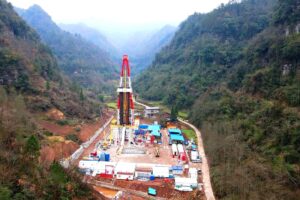Human-caused emissions of aerosols – tiny, light‑scattering particles produced mainly by burning fossil fuels – have long acted as an invisible brake on global warming.
This is largely because they absorb or reflect incoming sunlight and influence the formation and brightness of clouds.
These combined effects act to lower regional and global temperatures.
Aerosols also have a substantial impact on human health, with poor outdoor air quality from particulate matter contributing to millions of premature deaths per year.
Efforts to improve air quality around the world in recent decades have reduced aerosol emissions, bringing widespread benefits for health.
However, while cutting aerosols clears the air, it also unmasks the warming caused by carbon dioxide (CO2) and other greenhouse gases (GHGs).
In this explainer, Carbon Brief unpacks the climate effects of aerosols, how their emissions have changed over time and how they could impact the pace of future warming.
Key points include:
- Clean air rules are driving a rapid decline in sulphur emissions around the world. Global sulphur dioxide (SO2) emissions have fallen by around 40% since the mid‑2000s.
- There is around half a degree of warming today that is “hidden” by aerosols. Without the cooling from sulphate and other aerosols, today’s global temperature would already be close to 2C above pre‑industrial levels, rather than the approximately 1.4C the world is currently experiencing.
- Chinese SO2 emissions have fallen by more than 70% between 2006 and 2017 as the national government has brought in a series of air-pollution measures. These declines have added around 0.06C to global warming since 2006.
- Shipping’s low‑sulphur fuel rules have added to recent warming. The International Maritime Organization’s (IMO’s) 2020 cap on marine‑fuel sulphur has already warmed the planet by an estimated 0.04C, albeit with a wide range of estimates across published studies.
- Roughly one‑quarter of the increase in global temperature over the past two decades stems from this unmasking of human-caused heat. Altogether, recent aerosol cuts may have contributed ~0.14C of the ~0.5C of warming the world has experienced since 2007.
- By unmasking warming from CO2 and other GHGs, aerosols have flipped from reducing the rate of decadal warming (as emissions increased) to increasing the rate of warming (as emissions decreased) after 2005.
- Sulphate and other aerosols are a major component of PM2.5 air pollution, which has been linked to millions of premature deaths each year.
- Most future‑emissions pathways project continued aerosol declines. Unless methane and other short-lived GHGs fall at the same time, the rate of warming could accelerate in the coming decades even if CO2 emissions plateau.
Aerosol emissions
The term “aerosols” can be a source of confusion as it often evokes images of spray cans and concerns over depletion of the ozone layer. However, aerosols are a broad category that refer to solid or liquid particles that are fine enough to remain suspended in the atmosphere for extended periods of time.
The major climate-relevant aerosols include SO2, nitrate (NO3), ammonia (NH4), mineral dust, sea spray and carbonaceous aerosols, such as black carbon and organic aerosols.
They vary in size – from nanometres to tens of micrometres – and generally have a short residence time in the lower atmosphere, lasting days to weeks before drifting back to the surface or being washed out in rain.
This means that unlike long-lived GHGs, such as CO2 or nitrous oxide (N2O), aerosols only continue to impact the climate while they are being released. If emissions stop, their climate impacts quickly dissipate.
Aerosols affect the climate by absorbing or reflecting incoming sunlight, or by influencing the formation and brightness of clouds. Most aerosols have a cooling impact because they scatter sunlight away from the Earth and back to space. However, others, including black carbon, cause warming by absorbing incoming sunlight and heating the lower atmosphere.
The figure below shows climate model output looking at the global temperature impact of each different driver of climate change (referred to as “climate forcings” or “radiative forcings”) individually. It includes GHGs, aerosols and other human-caused drivers (such as land albedo changes or tropospheric ozone), as well as natural factors (such as volcanoes and variations in solar output).
Lines above zero show forcings that have an overall warming impact, while those below zero have a cooling effect.
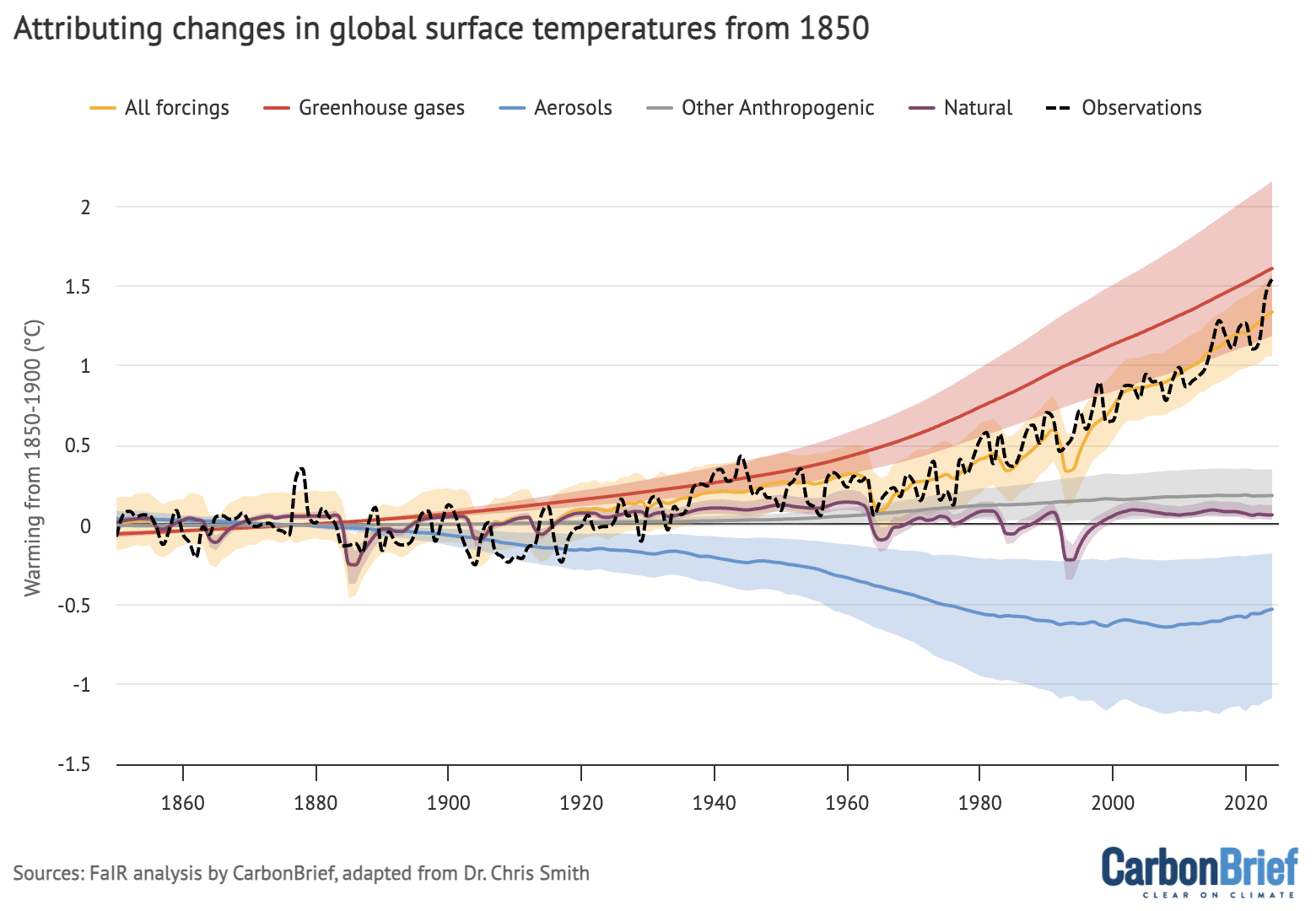
Global average surface temperature changes between 1850 and 2024 caused by each category of climate forcing. Calculated based on the FaIR climate model by comparing all-forcing model simulations to those with an individual forcing removed, following an approach developed by Dr Chris Smith. Observed surface temperatures (using the WMO average of six groups) are shown by the dashed black line.
The warming associated with GHG emissions and cooling associated with aerosol emissions are the largest factors driving the global temperature changes, particularly over the past 70 years.
In the absence of aerosol emissions, the best estimate of current warming would be approximately 0.5C higher, with the world approaching 2C rather than the 1.4C that the world is experiencing today.
Cooling from aerosols has likely masked a substantial portion of the warming that the world would otherwise have experienced.
Different aerosols and their climate effects
There are a number of different types of aerosols, whose climate impacts vary based on both the properties of the particles and the magnitude of human emissions. Of these, SO2 – often referred to as just “sulphur” – has the largest climate impact and is responsible for the bulk of aerosol masking (around -0.5C) that is occurring today.
Black carbon has a modest warming effect on the climate globally (~0.1C), but a much larger impact on Arctic temperatures where it can darken snow and ice, increasing the sunlight they absorb from the sun.
Organic carbon emissions have a modest cooling effect (around -0.1C), while emissions of ammonia and nitrate have an even-smaller cooling effect (around -0.02C). Others, such as dust and sea salt, are primarily natural and changes have had negligible effects on global temperatures.
The table below, adapted from the IPCC AR6 climate science report, provides details on the major aerosols, including their primary sources, effective radiative forcing and temperature impacts over the 1750-2019 period.
| Aerosol type | Primary sources | Effective radiative forcing in watts per metre squared (w/m2), 1750-2019 | Temperature impact, 1750-2019 |
|---|---|---|---|
| Sulphur / Sulphate (SO4) | Fossil fuel and biomass SO2 | -0.9 (-1.6 to -0.3) | Strong cooling with -0.5C (-0.1C to -0.9C) of offset warming globally. Dominant aerosol cooling component. |
| Black carbon (BC) | Incomplete combustion (diesel, coal, biomass) | 0.1 (-0.2 to 0.4) | Warming of 0.1C globally (-0.1C to 0.3C). Offsets some cooling; major regional Arctic impact. |
| Organic carbon (OC) | Biomass burning, biofuel and volatile organic compounds (VOCs) | -0.2 (-0.4 to 0.0) | Cooling of -0.1C globally (-0.2C to 0C). |
| Nitrate (NO3) and ammonia (NH3) | Nitrous oxide (NOX) from vehicles and industry and ammonia (NH3) from agriculture | -0.03 (-0.07 to 0.00) | Small global cooling effect of -0.02C (-0.05C to 0.01C). Regionally important where ammonia is abundant. |
| Dust (mineral) | Natural (deserts); some land-use change | ~0 (uncertain, ±0.1) | Small globally with an uncertain sign, but potentially larger regional effects. Anthropogenic fraction of dust forcing is small. |
| Sea salt | Ocean spray (natural) | 0 (natural baseline) | No trend or forcing attributable to human activity. |
Aerosol cooling was relatively modest until around 1950, after which SO2 emissions substantially increased worldwide, driven by a rapid increase in coal combustion and industrial activity.
The cooling effect of aerosols peaked around the year 2000 and has been declining over the past two decades. The figure below highlights the impact of aerosols on global temperature change over time.
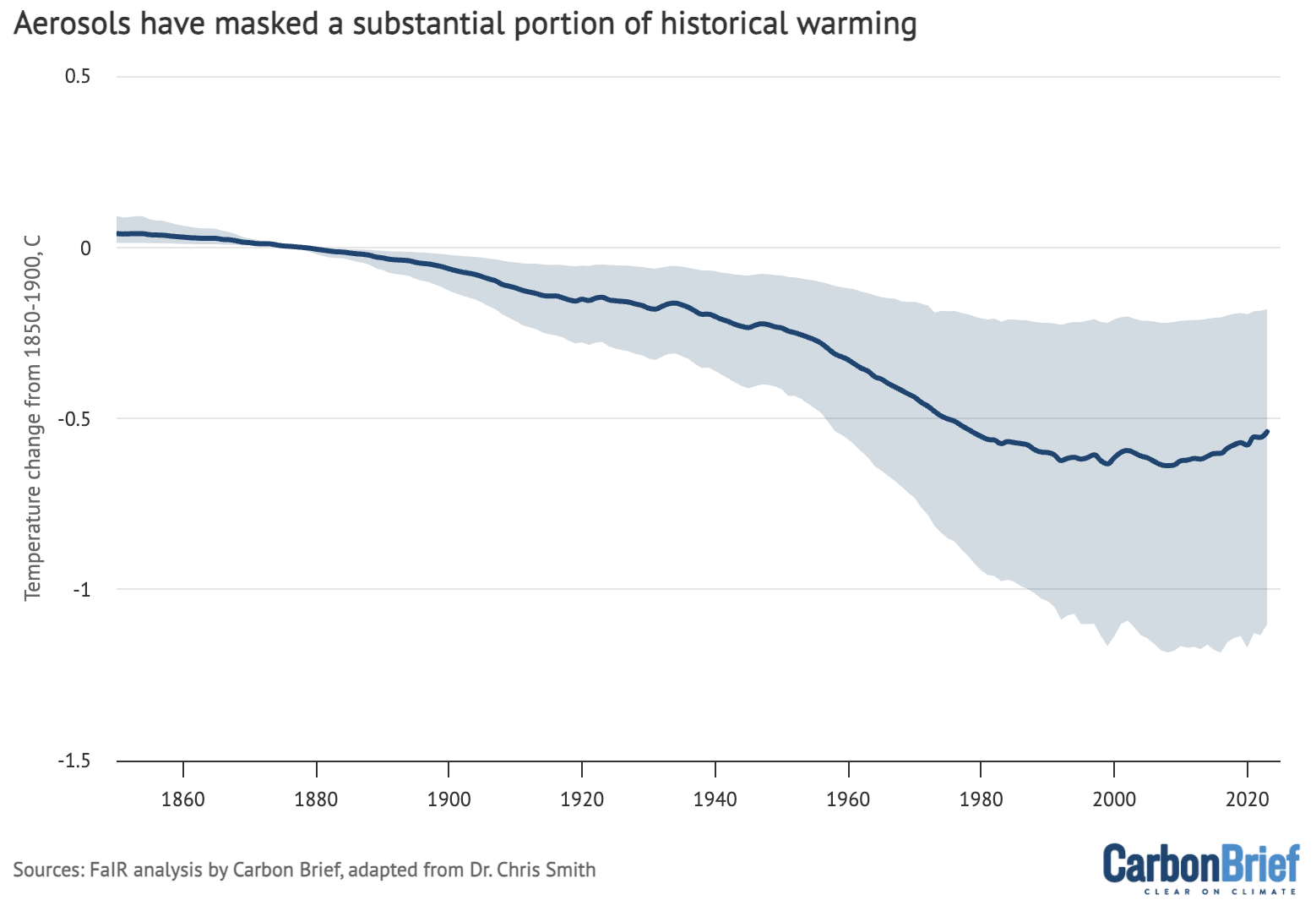
Global average surface temperature changes over 1850-2024 caused by aerosols, based on the FaIR climate model.
However, the cooling effects of aerosols remain uncertain due both to their regional nature and the complex nature of interactions between aerosols and clouds.
There is also a relationship between aerosol forcing and climate sensitivity, which is a measure of how much warming is expected from a doubling of atmospheric CO2. In general, climate models with a higher sensitivity tend to have higher aerosol cooling that counterbalances the larger GHG-driven warming. The reduction of uncertainty in aerosol cooling – particularly the effects of aerosols on cloud formation – is a major focus of scientists in their attempts to reduce the uncertainty in climate sensitivity estimates.
The climate impacts of aerosols are broadly divided into two groups, shown in the chart below. The first is a direct effect (blue line), where they scatter and absorb incoming radiation from the sun, preventing it reaching the Earth’s surface. The second is an indirect effect (dark blue line) on cloud formation, where aerosols serve as “condensation nuclei” around which clouds form.
For example, aerosols can enhance the coverage, reflectance and lifetime of low-level clouds, causing a strong cooling effect.
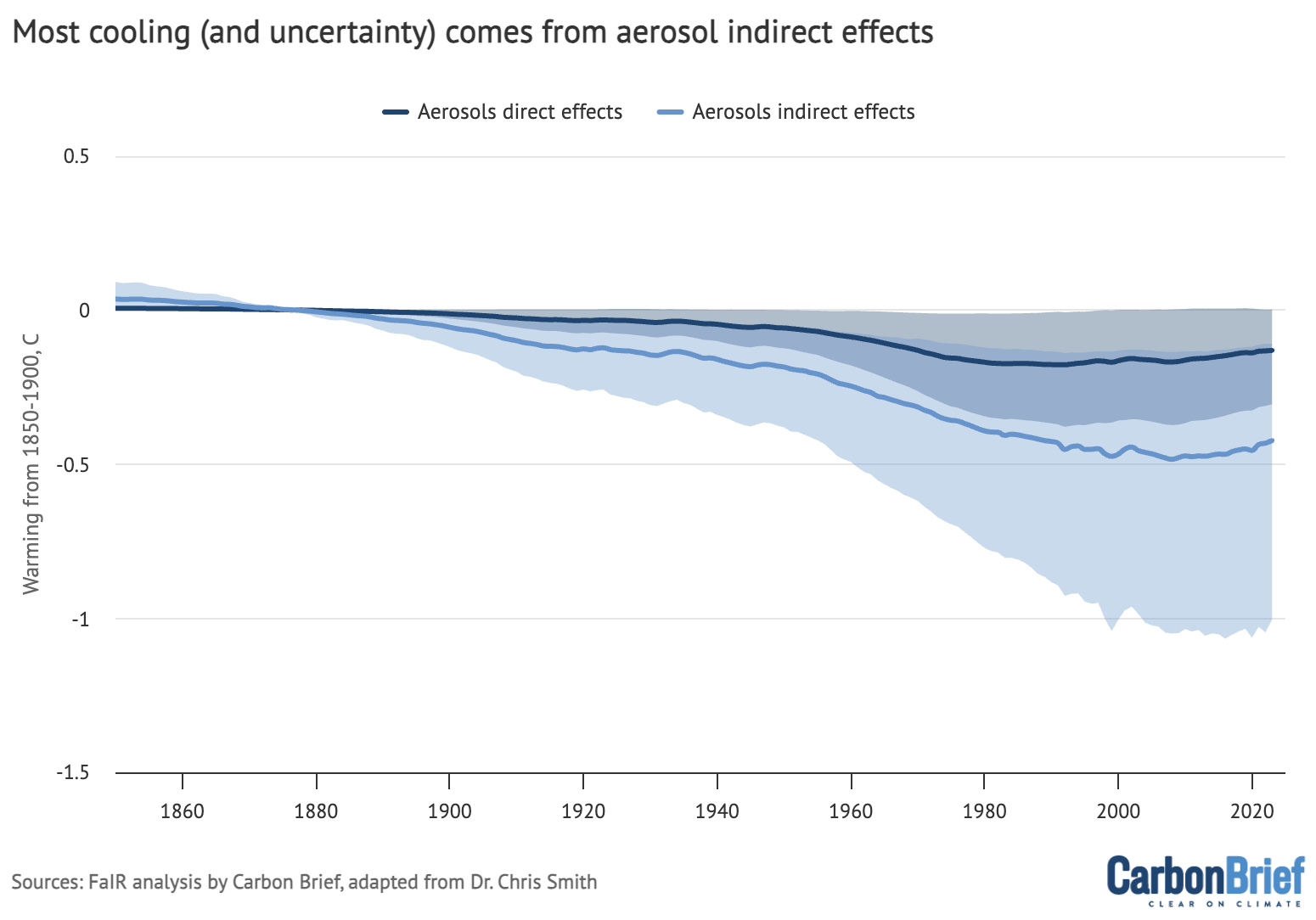
Global average surface temperature changes between 1850 and 2024 caused by direct and indirect aerosol effects, based on the FaIR climate model.
Of the two, direct aerosol effects generally have the smaller effect, with less uncertainty around their impact. They cool the planet by around -0.13C (-0.31C to 0C) today.
Indirect aerosol effects have a larger magnitude and uncertainty, with a -0.42C (-1C to -0.11) cooling impact globally today.
The recent sixth assessment report (AR6) report from the Intergovernmental Panel on Climate Change (IPCC) increased the estimated magnitude of indirect aerosol forcing, compared to the fifth assessment report (AR5). This increase was based on an improved understanding and modelling of aerosol-cloud adjustments.
While global average temperature is the focus here, it is important to note that – unlike CO2 and other GHGs – aerosols in the lower atmosphere are not “well mixed”. That is, they are not spread evenly through the atmosphere.
Rather, their short lifetime results in strong regional variation in aerosol concentrations and associated climate effects, which can have a large impact on local temperature and rainfall extremes. Regions such as east or south-east Asia, which have high sulphur emissions, have experienced larger aerosol cooling than regions with lower emissions.
The one exception is when aerosols are injected higher up in the atmosphere in the stratosphere. There, they tend to have a much longer lifetime – measured in years rather than days – and are much more well-mixed.
(Today, meaningful increases in stratospheric aerosols only occur as a result of particularly explosive eruptions of sulphur-rich volcanoes, which cool the Earth for a few years after a major eruption. However, intentionally introducing sulphate aerosols into the stratosphere has been proposed as a potential “geoengineering” strategy to temporarily mask the effects of warming. These ideas have been controversial in the scientific community.)
Aerosol emissions have a huge impact on public health. The substances are generally considered to be conventional air pollutants and are precursors of fine particulate matter air pollution (PM2.5).
Outdoor air pollution associated with sulphur and other aerosol emissions contributes to millions of premature deaths annually. As a result, much of the impetus to rapidly cut aerosols arises from public health concerns. Despite the contribution to more rapid warming, a reduction in aerosols represents a massive improvement in health and welfare for people worldwide.
Rapid declines in global sulphur emissions
Global emissions of the most climatically important aerosol – SO2 – have declined precipitously since peaking around 50 years ago.
SO2 cuts were initially driven by clean air regulations adopted by the US, UK and EU in the 1970s and 1980s in response to the growing effects of SO2 on both air pollution and acid rain.
As the figure below illustrates, SO2 emissions across the US, UK and EU have subsequently fallen from 68m tonnes per year in 1973 to just 3.3m tonnes per year today.
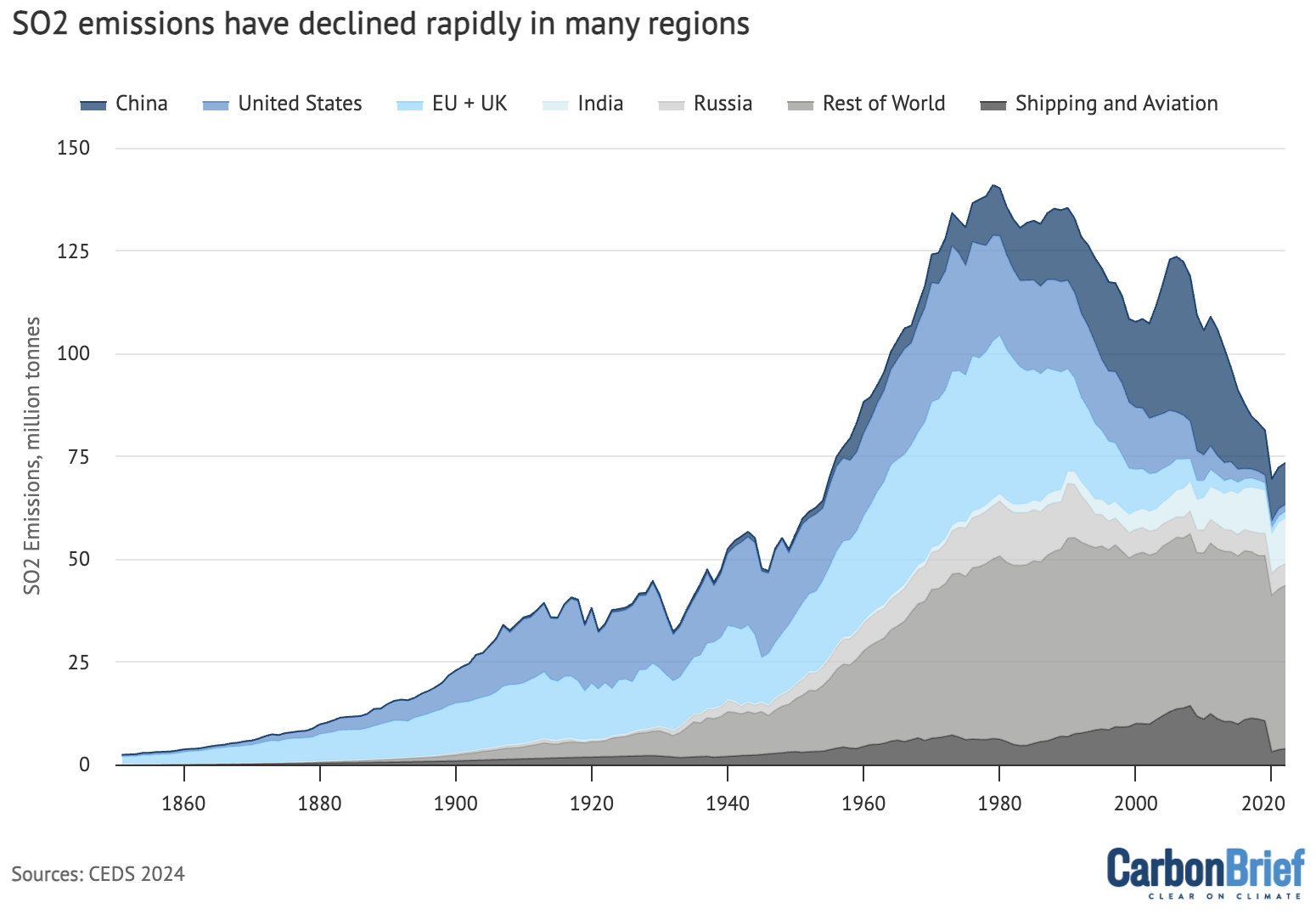
Annual SO2 emissions by country and by international shipping and aviation, 1850-2022. Data from the Community Earth atmospheric Data System (CEDS).
In the first decade of the 21st century, SO2 cuts in the UK, US and EU were counterbalanced by growing SO2 emissions in China, driven by a rapid expansion of coal use and industrial activity.
Between 2000 and 2007, global SO2 emissions saw a renewed increase, as China’s SO2 emissions reached 38m tonnes per year by 2006.
However, following an international and domestic focus on air pollution in the aftermath of the 2008 Beijing Olympics, China embarked on an ambitious programme to clean up air pollution. The nation has since cut its SO2 emissions by more than 70% to around 10m tonnes of SO2 today.
Meanwhile, SO2 emissions from global shipping recently dropped by around 65%, after the IMO instituted regulations requiring the use of low-sulphur marine fuels from 2020.
Many other countries have also broadly seen aerosol declines since 1990, although there are exceptions. For example, India’s expansion of coal generation has driven increasing SO2 emissions.
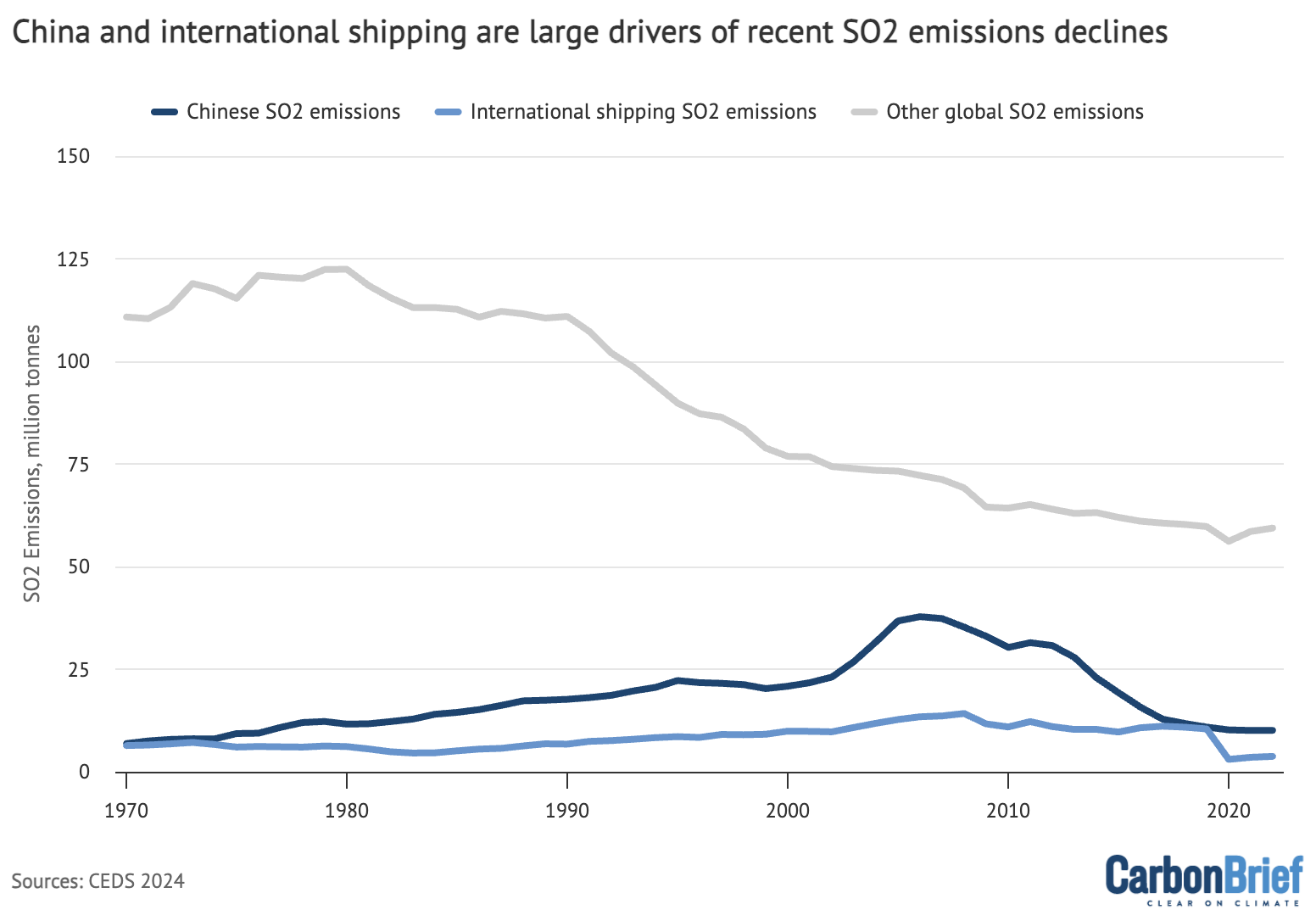
Annual SO2 emissions from China, international shipping and the rest of the world. Data from the Community Earth atmospheric Data System (CEDS).
While global SO2 emissions started decreasing in the 1980s, these declines were relatively modest until around 2008, after which they have dropped precipitously.
Global SO2 emissions today are 48% lower than they were in 1979 and 40% lower than in 2006.
It is this recent rapid decline in global SO2 emissions that has driven the reduction in overall global aerosol cooling – and a subsequent decline in the associated masking of GHG warming – discussed earlier.
Effects of low-sulphur shipping fuel
The climate effects of the IMO’s 2020 phase-out of most of the sulphur content in shipping fuel has received a lot of attention over the past two years (see Carbon Brief’s earlier coverage of the topic).
This has been explored by researchers as a potential explanation for the record levels of warming the world has experienced in recent years.
Determining the climate effects of low-sulphur shipping fuel is less straightforward than simply assessing the reduction in global SO2 emissions.
The impact of additional SO2 emissions on cloud formation diminishes as emissions increase, meaning that reductions in SO2 over areas with low background sulphate concentrations, such as the ocean, could result in a proportionately larger warming effect than in highly polluted areas, such as south Asia.
This is somewhat countered by the concentration of shipping in specific “lanes” and by natural emissions of dimethyl sulphide produced by algae that are not present on land. Assessing the radiative forcing impact of the IMO’s 2020 regulations in greater detail requires the use of sophisticated climate models that can simulate these regional effects.
Carbon Brief conducted a survey of the literature on the climate impacts of the 2020 low-sulphur marine fuel regulations. Of eight studies published in peer-reviewed journals over the past two years, shown in the chart below, most determined a radiative forcing change of around 0.11 to 0.14 watts per meter squared (w/m2).
One estimate from Skeie et al. (2024) was a bit lower at around 0.08 w/m2 and another from Hansen et al. (2025) was substantially higher than all the others at 0.5 w/m2.
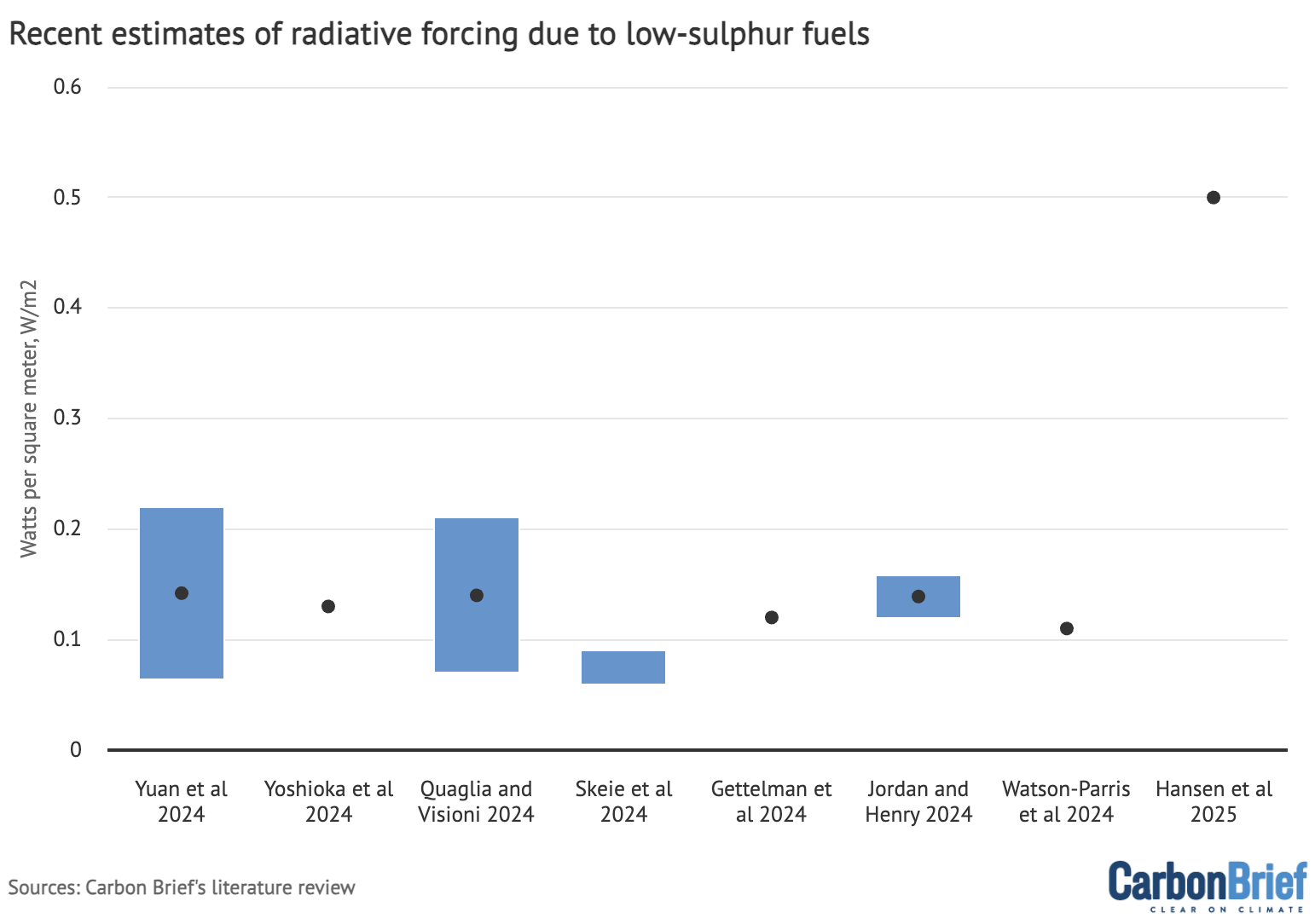
Estimates of global average radiative forcing changes from the IMO 2020 regulations published in the last two years. See the Methodology section for links to individual studies.
To account for these differing studies, Carbon Brief used the FaIR climate model emulator to simulate the effects of the radiative forcing estimated in each study on global average surface temperatures between 2020 and 2030. This includes 841 different simulations for each study to account for uncertainties in the climate response to aerosol forcing. (See: Methodology for further details.)
These estimates were then all combined to provide a central estimate (50th percentile) that gives each study equal weight, as well as a 5th to 95th percentile range across all the simulations for each different forcing estimate, as shown in the figure below.
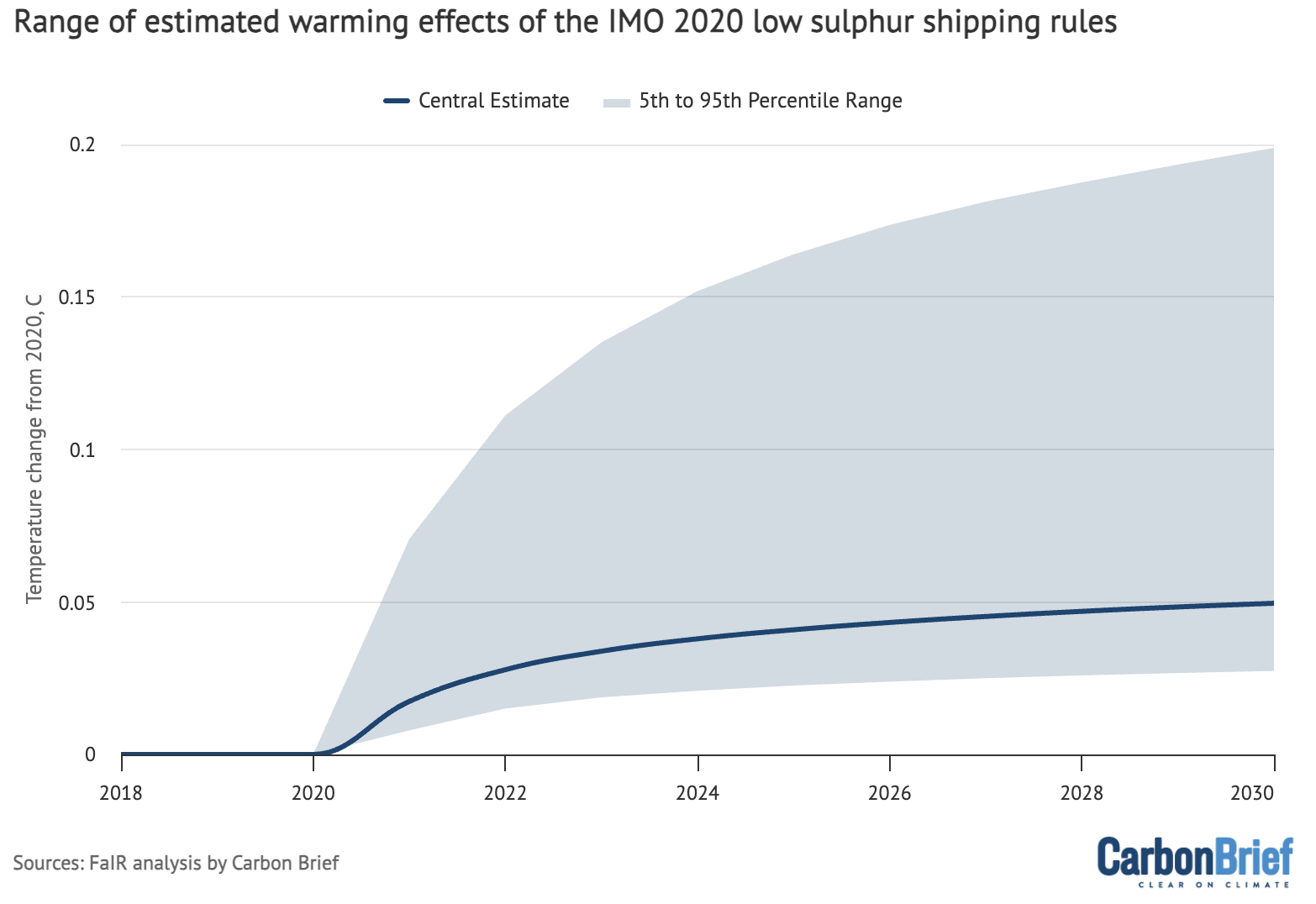
Range (5th to 95th percentile) and central estimate (50th percentile) of simulated global average surface temperature responses to the IMO 2020 regulations across the radiative forcing estimates in the literature. Analysis by Carbon Brief using the FaIR model.
Overall, this approach provides a best estimate of 0.04C (0.02C to 0.16C) additional warming from the IMO’s 2020 regulations as of 2025, increasing to 0.05C (0.03C to 0.2C) by 2030.
These large uncertainty ranges are due to the inclusion of the Hansen et al. (2025) estimate, which represents something of an outlier relative to other published studies. Note that the warming of the climate system associated with the IMO 2020 regulations increases over time in the plot due to the ocean’s slow rate of warming buffering the climate response to forcing changes.
Declines in Chinese SO2 are unmasking warming
China’s reduction of SO2 emissions by more than 70% since 2007 represents a remarkable public health success story. It is estimated to have prevented hundreds of thousands of premature deaths from air pollution annually.
These rapid emissions cuts by China represent more than half the reduction in global SO2 emissions since 2007. They have been a major contributor to global temperature increases over the past two decades.
To determine the impact of Chinese SO2 reductions on global average surface temperatures, Carbon Brief used Chinese SO2 emissions data from the Community Emissions Data System (CEDS) combined with the FaIR climate model emulator.
The figure below shows the central estimate and 5th to 95th percentile across 841 different FaIR model simulations to account for uncertainties in the climate response to SO2 emissions.
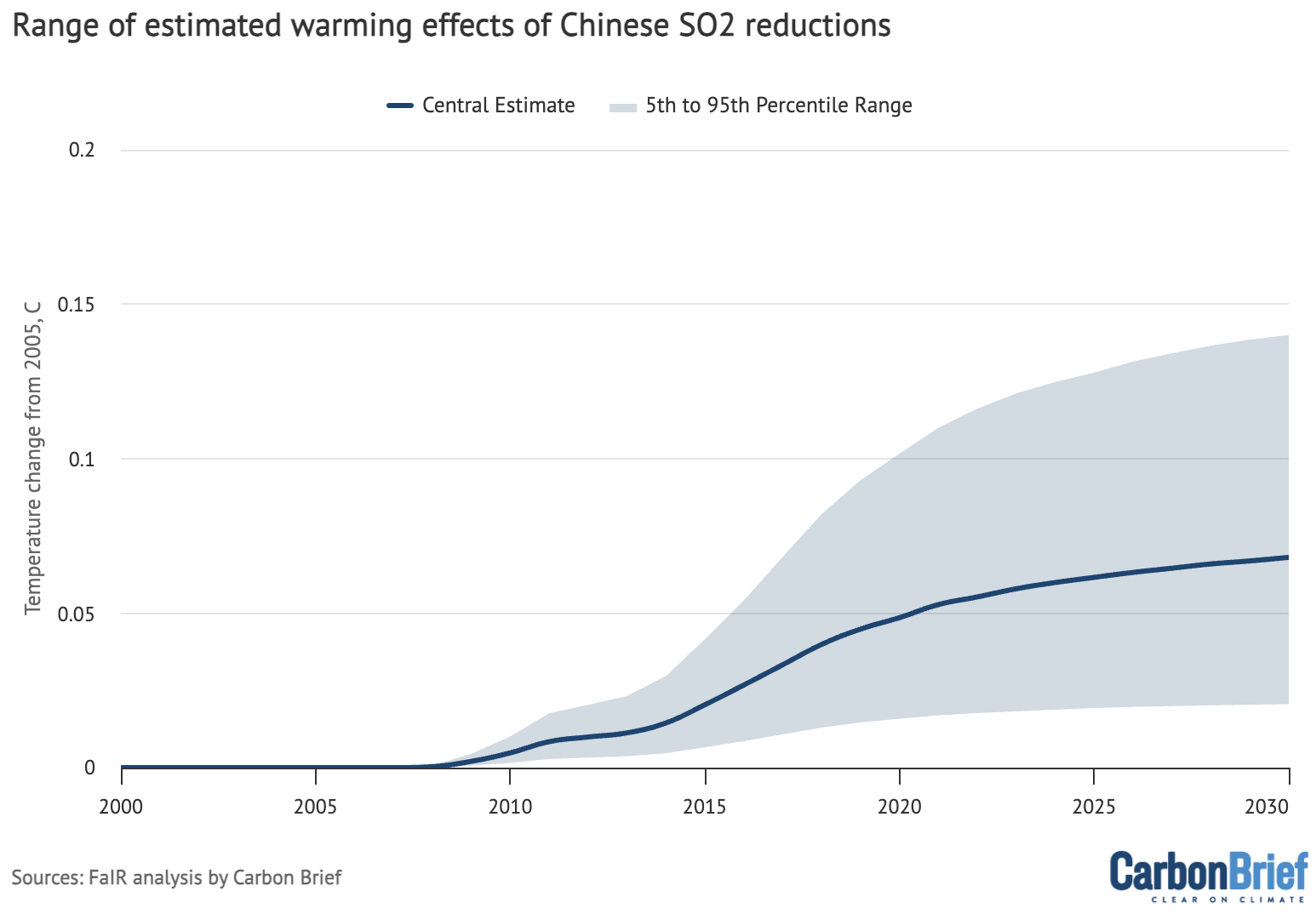
Range (5th to 95th percentile) and median (50th percentile) of simulated global mean surface temperature responses to declines in Chinese SO2 emissions. Analysis by Carbon Brief using the FaIR model.
The figure above shows that Chinese SO2 declines were likely responsible for a global temperature increase of around 0.06C (0.02C to 0.13C) between 2007 and 2025, increasing to 0.7C (0.02C to 0.14C) by 2030.
Much of this increase occurred between 2007 and 2020, with a more modest contribution of Chinese aerosol changes to warming in recent years.
These results are nearly identical to those found in a study currently undergoing peer review by Dr Bjørn Samset and colleagues at CICERO, which finds a best estimate of 0.07C (0.02C to 0.12C) using a large set of simulations from eight different Earth system models.
This suggests that Chinese SO2 reductions are responsible for approximately 12% of the around 0.5C warming the world experienced between 2007 and 2024.
What aerosol cuts mean for current and future warming
It is clear that rapid reductions in global SO2 emissions have had a major impact on the global climate.
The combination of declines in emissions since 2007 in China and the rest of the world, along with declines in SO2 from shipping after 2020, have collectively unmasked a substantial amount of warming driven by GHGs.
While the reduction in SO2 emissions in other countries has been proportionately smaller than that seen in China, collectively it adds up to 0.03C (0.01C to 0.07C) of warming in 2025.
The figure below provides a best-estimate of all three factors: declines in SO2 emissions in shipping, China and the rest of the world.
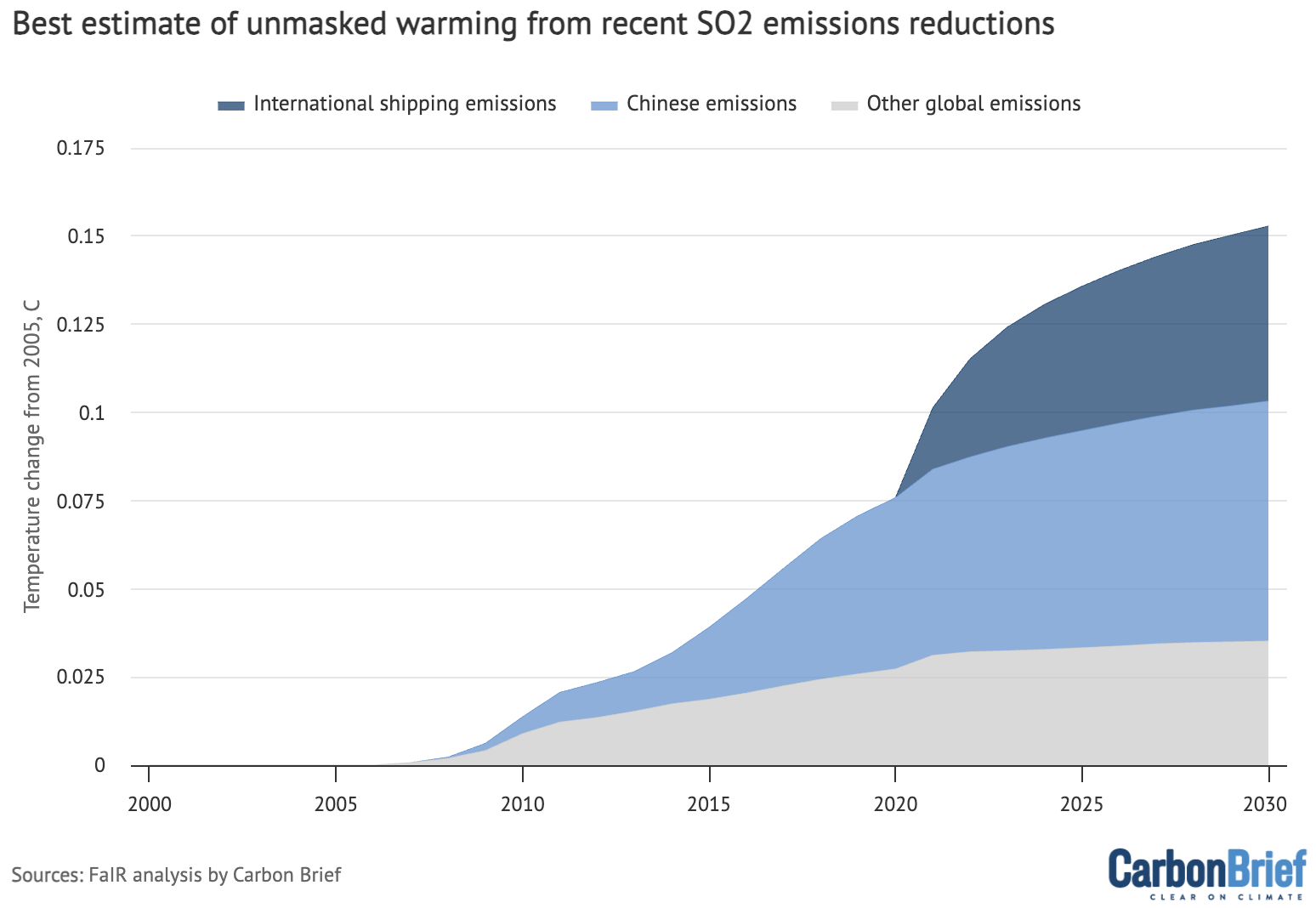
Combined central (50th percentile) estimates of modeled global average surface temperature changes from IMO 2020, Chinese SO2 and rest-of-world SO2 declines between 2005 and 2030. Analysis by Carbon Brief using the FaIR model.
Taken together, these declines in SO2 emissions may represent around 0.14C additional warming today, or more than a quarter of the approximately 0.5C warming the world has experienced between 2007 and 2024.
However, the uncertainty in the climate response to changes in aerosol emissions remains large, particularly for changes in shipping emissions, so it is hard to rule out either a much smaller or much larger effect.
These results are in line with other recent analyses showing that changes in aerosol emissions are contributing to an increase in the rate of human-caused global warming in recent years.
The figure below uses a similar FaIR-based climate modeling approach to assess how different factors contributing to human-caused warming have changed over time.
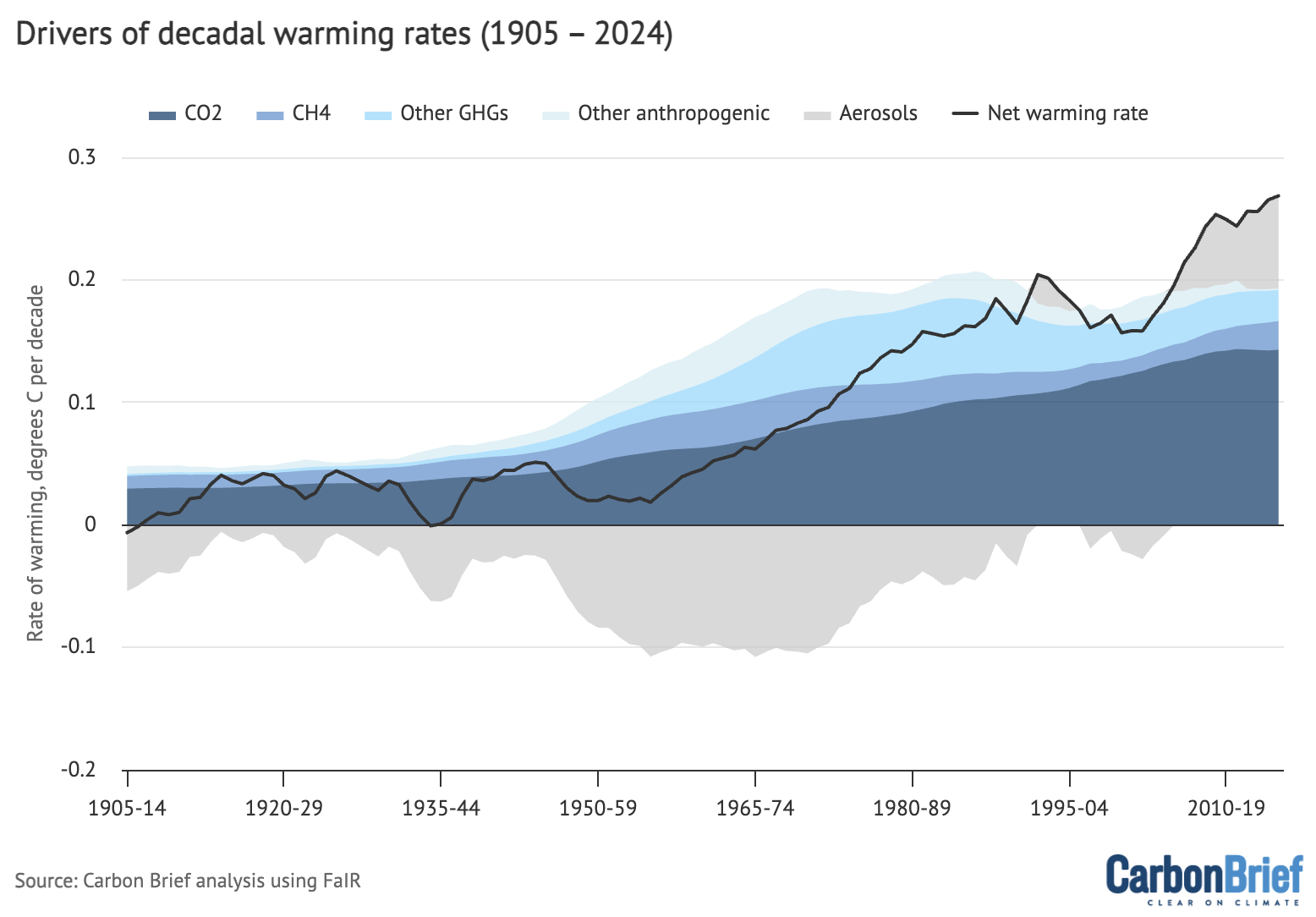
Drivers of decadal warming rates between 1970-1979 and 2015-2024, excluding natural factors like volcanoes and solar cycle variation. From an analysis using the FaIR model at The Climate Brink, adapted from earlier work by Dr Chris Smith.
This shows that the rate of human-caused warming remained relatively flat at around 0.18C per decade from 1980 to 2005, before accelerating to around 0.27C over the past decade.
The primary driver of this recent acceleration in warming has been declining aerosol emissions.
Aerosols have flipped from reducing the rate of decadal warming (as emissions increased) to increasing the rate of warming (as emissions decreased) after 2005 by unmasking warming from CO2 and other GHGs.
The rate of warming from CO2 has increased over time as emissions have increased, though it has plateaued over the past decade as increases in global emissions have slowed.
However, the rate of warming from all GHG emissions – CO2, methane and others – has been relatively consistent since 1970. This is primarily due to the declining contribution of other GHGs to additional warming, likely associated with the phaseout of halocarbons after the Montreal Protocol.
Future declines in aerosols are expected in most of the Shared Socioeconomic Pathways (SSPs) used to simulate potential levels of future warming for the IPCC AR6 report, as shown in the figure below.
Modelled future SO2 emissions are generally dependent on broader mitigation trends – worlds with less fossil-fuel use result in less sulphur emissions – but are also highly variable across different models.
Observed SO2 emissions (black line) are broadly at the same level as (though slightly below) the SSP2-4.5 scenario (yellow line), which is the pathway that most closely matches current climate policies.
Observed SO2 emissions are also similar to those in the very-high emissions SSP5-8.5 scenario (lower grey line), while being higher than emissions in the most ambitious mitigation scenario (SSP1-1.9, green line) and below those in the SSP1-2.6 scenario (navy blue line).
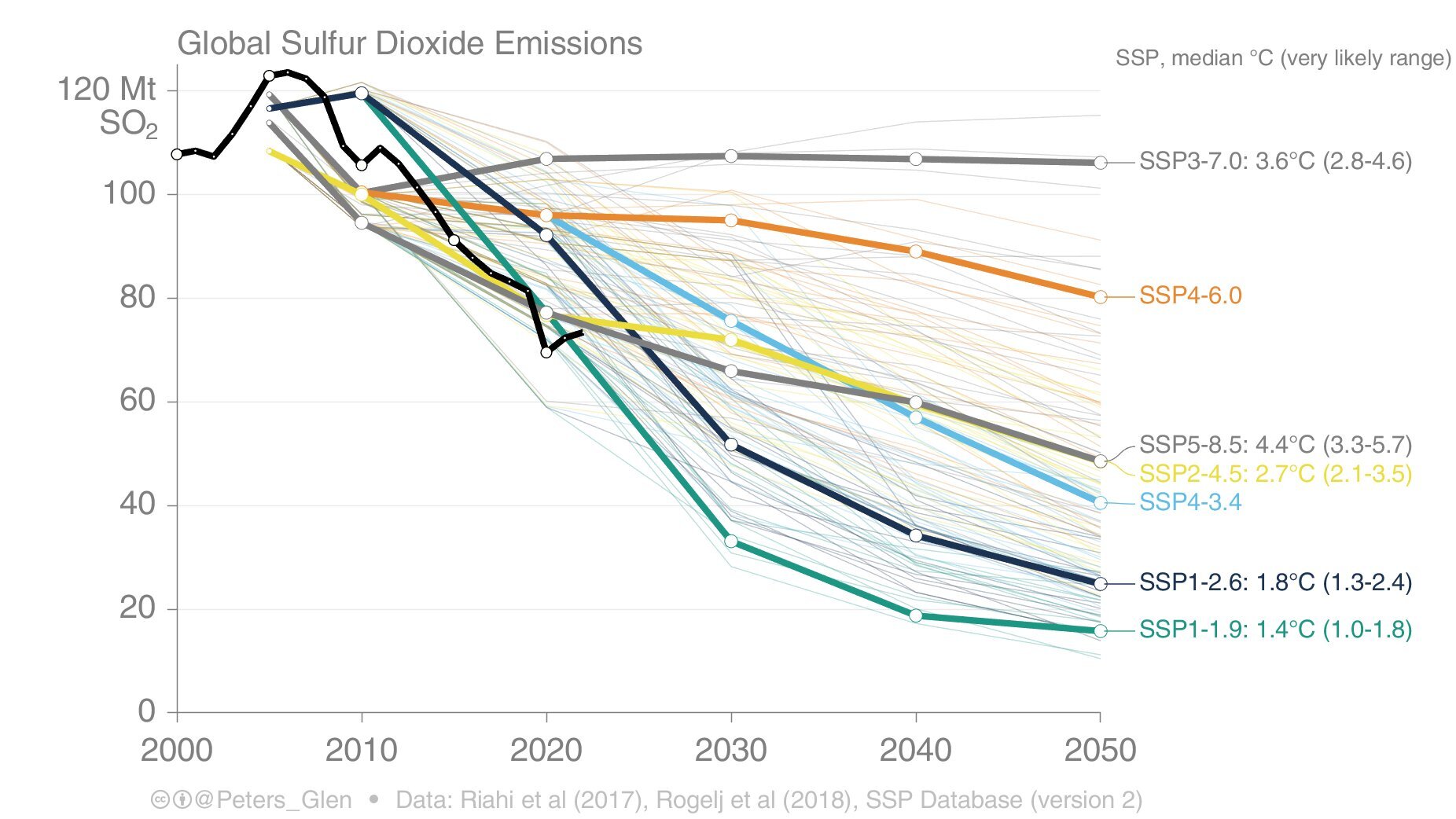
Given differences across modeling groups, it is hard to infer too much about which SSP scenario is most in line with real-world SO2 emissions. However, it is worth noting that the current SSPs do not include a scenario where SO2 emissions continue to rapidly decline while emissions of CO2 and other GHGs increase.
Interestingly, the best-estimate cooling effect from sulphur dioxide is more or less counterbalanced by the warming effect of methane emissions today. As a result, scenarios where all GHG emissions are brought to zero do not result in sustained additional warming due to unmasking from declining aerosols.
However, if CO2 emissions alone were reduced to zero, while non-CO2 emissions were held constant, cutting global aerosol emissions to zero would result in between 0.2C and 1.2C of additional warming.
This means that aerosol emissions represent something of a wildcard for future warming over the 21st century. Continued rapid reductions in SO2 emissions will contribute to an acceleration in the rate of global warming in the coming years.
Methodology
Carbon Brief used the FaIR climate model to determine the effects of aerosol emissions on the climate, building on the work of Dr Chris Smith. Runs were done using the constrained ensemble approach using “fair-calibrate v1.4.”1 to be consistent with the IPCC AR6 parameter range. More details on the constrained ensemble approach can be found in Smith et al. (2024).
Figures showing the global mean surface temperature impact of different climate forcings in isolation were performed by calculating the difference between all-forcing runs and runs where a single forcing (e.g. from GHG emissions) was removed, following the approach used to generate Figure 7.8 in the IPCC AR6 climate science report.
IMO 2020 forcing estimates were taken from the following studies published in the peer-reviewed literature over the past two years:
- Yuan et al. (2024)
- Yoshika et al. (2024)
- Quaglia and Visioni (2024)
- Skeie et al. (2024)
- Gettelman et al. (2024)
- Jordan and Henry (2024)
- Watson-Parris et al. (2024)
- Hansen et al. (2025)
IMO 2020 global average surface temperature changes were calculated by running 841 different FaIR simulations for each of the different forcing estimates identified in the literature, which is the default setting for the FaiR constrained ensemble to provide a range of results consistent with the IPCC AR6 parameter range.
This produced 6,728 total simulations, from which a central (50th percentile) estimate and uncertainty range (5th to 95th percentile) were calculated.
These results were further validated by comparing them to the Earth system model-based estimates in individual studies where near-term global average surface temperature change estimates were provided (Yoshika et al. (2024); Quaglia and Visioni (2024); Gettelman et al. (2024); Jordan and Henry (2024); Watson-Parris et al. (2024); and Hansen et al. (2025).
The results of each of these studies were within the range of FaIR based estimates for the respective study’s radiative forcing – and generally quite close to FaIR’s median estimate for that study, as shown in the table below.
| Study | Carbon Brief’s Estimate (2025) | Published Estimate |
|---|---|---|
| Yoshika et al., 2024 | 0.041C (0.032C to 0.053C) | 0.04C |
| Quaglia and Visioni, 2024 | 0.044C (0.034C to 0.057C) | 0.08C (0.05C to 0.11C) |
| Gettelman et al., 2024 | 0.038C (0.029C to 0.049C) | 0.04C |
| Jordan and Henry 2024 | 0.044C (0.034C to 0.057C) | 0.046C (0.036C to 0.056C) |
| Watson-Parris et al., 2024 | 0.035C (0.027C to 0.045C) | 0.03C (-0.09C, 0.19C) |
| Hansen et al., 2025 | 0.157C (0.123C to 0.205C) | 0.2C |
It is worth noting that the uncertainties associated with converting SO2 forcing estimates to warming outcomes are generally much smaller than converting SO2 emissions into warming outcomes.
The effect of Chinese SO2 reductions were based on a comparison of two scenarios. The first is where Chinese SO2 emissions remained constant at their peak (2007) levels and did not decline. The second is where Chinese emissions followed observational estimates from CEDS between 2005 and 2022 and then remained constant at 2022 levels thereafter (which represents a conservative assumption that likely underestimates future effects of SO2 emissions declines on global temperatures given the strong downward trend). Global average surface temperature changes were calculated by running 841 different FaIR simulations in emissions mode for two scenarios and analysing the difference between the two.
The resulting estimate of 0.06C (0.02C to 0.13C) warming by 2025 was validated by comparing it to the Samset et al. (2025) preprint, which finds a nearly identical best estimate of 0.07C (0.02C to 0.12C) using a large set of simulations from eight different Earth system models.
The effects of the rest of the world’s SO2 declines were estimated using the same approach used for Chinese SO2 emissions, using CEDS emissions data. International shipping and aviation aerosols were excluded from the rest of the world estimate as to not double count IMO 2020 effects.
The post Explainer: How human-caused aerosols are ‘masking’ global warming appeared first on Carbon Brief.
Explainer: How human-caused aerosols are ‘masking’ global warming
Greenhouse Gases
DeBriefed 10 October 2025: Renewables power past coal; Legacy of UK’s Climate Change Act; Fukushima’s solar future
Welcome to Carbon Brief’s DeBriefed.
An essential guide to the week’s key developments relating to climate change.
This week
Renewables overtake coal
‘HISTORIC FIRST’: Renewables have overtaken coal to become the world’s leading source of electricity for the first six months of this year in a “historic first”, BBC News said. The analysis, from the thinktank Ember, found the world generated “almost a third” more solar power in the first half of the year, compared with the same period in 2024, while wind power grew by “just over 7%,” reported the Guardian.
HEAVY LIFTING: According to the report, China and India were “largely responsible for the surge in renewables”, while the US and Europe “relied more heavily on fossil fuels,” the Guardian wrote. China built more renewables than every other country combined in the first half of this year, the newspaper added.
CONTINENTAL SHIFTS: A second report from the International Energy Agency (IEA) predicted a “surge” in global wind and solar capacity by 2030, but shaved 5% off its previous forecast, the Financial Times said. The IEA revealed that India is set to become the second-largest growth market for renewables after China, “with capacity expected to increase 2.5 times by 2030”, Down to Earth reported. The IEA also upped its forecast for renewables in the Middle East and north Africa by 23%, “helped by Saudi Arabia rolling out wind turbines and solar panels”, but halved the outlook for the US, the FT noted.
Around the world
- EV BOOM: Sales of electric and hybrid cars made up “more than half” of all new car registrations in the UK last month, a new record, according to data from the Society of Motor Manufacturers, reported BBC News.
- BANKING COLLAPSE: A global banking alliance launched by the UN to get banks to slash the carbon footprint of their loans and investments and help drive the transition to a net-zero economy by 2050 has collapsed after four years, Agence France-Press reported.
- CUTS, CUTS, CUTS: The Trump administration plans to cut nearly $24bn in funding for more than 600 climate projects across the US, according to documents reviewed by the Wall Street Journal.
- PEOPLE POWER: A farmer, a prison guard and a teacher were among those from the Dutch-Caribbean island Bonaire who appeared at the Hague on Tuesday to “accuse the Netherlands of not doing enough to protect them from the effects of climate change”, Politico reported.
400,000
The number of annual service days logged by the US National Guard responding to hurricanes, wildfires and other natural disasters over the past decade, according to a Pentagon report to Congress, Inside Climate News reported.
Latest climate research
- Politicians in the UK “overwhelmingly overestimate the time period humanity has left to bend the temperature curve”, according to a survey of 100 MPs | Nature Communications Earth and Environment
- Fire-driven degradation of the Amazon last year released nearly 800m tonnes of CO2 equivalent, surpassing emissions from deforestation and marking the “worst Amazon forest disturbance in over two decades” | Biogeosciences
- Some 43% of the 200 most damaging wildfires recorded over 1980-2023 occurred in the last decade | Science
(For more, see Carbon Brief’s in-depth daily summaries of the top climate news stories on Monday, Tuesday, Wednesday, Thursday and Friday.)
Captured

The UK’s Climate Change Act, landmark legislation that guides the nation’s response to climate change, is increasingly coming under attack from anti-net-zero right-leaning politicians. In a factcheck published this week, Carbon Brief explained how the UK’s Climate Change Act was among the first comprehensive national climate laws in the world and the first to include legally binding emissions targets. In total, 69 countries have now passed “framework” climate laws similar to the UK’s Climate Change Act, with laws in New Zealand, Canada and Nigeria among those explicitly based on the UK model. This is up from just four when the act was legislated in 2008. Of these, 14 are explicitly titled the “Climate Change Act”.
Spotlight
Fukushima’s solar future
This week, Carbon Brief examines how Fukushima helped to recover from nuclear disaster by building solar farms on contaminated farmland.
On 11 March 2011, an earthquake off the pacific coast of Japan caused 15m-tall waves to crash into the eastern region of Tōhoku, killing 19,500 people and injuring a further 6,000.
In the aftermath, flooding at the Fukushima Daichi nuclear power plant caused cooling systems to fail, leaching radioactive contaminants into the soil and leading to a major nuclear incident.
Some 1,200km2 around the site was restricted and up to 100,000 people were evacuated – in some cases forever.
In the years following, Japan entered a fraught debate about nuclear energy.
In 2010, nuclear power provided 25% of Japan’s electricity, but, in the years following the disaster, its 54 nuclear reactors were taken offline.
Successive governments have fought over reintroducing nuclear power. Today, some 14 reactors are back online, 27 have been permanently closed and another 19 remain suspended. (Japan’s newly-elected prime minister Sanae Takaichi has promised to make nuclear central to her energy strategy.)
Against this backdrop, Fukushima – a prefecture home to 1.8 million people – has emerged as a surprise leader in the renewables race.
In 2014, the Fukushima Renewable Energy Institute (FREA) opened with the twin goals of promoting research and development into renewable energy, while “making a contribution to industrial clusters and reconstruction”.
That same year, the prefecture declared a target of 100% renewable power by 2040.
Contaminated land
“A lot of these communities, I know, were looking for ways to revitalise their economy,” said Dr Jennifer Sklarew, assistant professor of energy and sustainability at George Mason University and author of “Building Resilient Energy Systems: Lessons from Japan”.
Once evacuation orders were lifted, however, residents in many parts of Fukushima were faced with a dilemma, explained Skarlew:
“Since that area was largely agricultural, and the agriculture was facing challenges due to stigma, and also due to the soil being removed [as part of the decontamination efforts], they had to find something else.”
One solution came in the form of rent, paid to farmers by companies, to use their land as solar farms.
Michiyo Miyamoto, energy finance specialist at the Institute for Energy Economics and Financial Analysis, told Carbon Brief:
“The [Fukushima] prefecture mapped suitable sites early and conducted systematic consultations with residents and agricultural groups before projects were proposed. This upfront process reduced land-use conflicts, shortened permitting timelines and gave developers clarity.”
As a result, large-scale solar capacity in Fukushima increased to more than 1,300 megawatts (MW) from 2012 to 2023, according to Miyamoto. Moreover, installed renewable capacity now exceeds local demand, meaning the region can run entirely on clean power when conditions are favourable, Miyamoto said.
Today, aerial pictures of Fukushima reveal how solar panels have proliferated on farmland that was contaminated in the nuclear disaster.

Charging on
Last year, 60% of Fukushima’s electricity was met by renewables, up from 22% in 2011. (The country as a whole still lags behind at 27%.)
And that is set to grow after Japan’s largest onshore windfarm started operations earlier this year in Abukuma, Fukushima, with a capacity of 147MW.
The growth of solar and wind means that Fukushima is already “ahead of schedule” for its 2040 target of 100% renewable power, said Miyamoto:
“The result is a credible pathway from recovery to leadership, with policy, infrastructure and targets working in concert.”
Watch, read, listen
OVERSHOOT: The Strategic Climate Risks Initiative, in partnership with Planet B Productions, has released a four-part podcast series exploring what will happen if global warming exceeds 1.5C.
DRONE WARFARE: On Substack, veteran climate campaigner and author Bill McKibben considered the resilience of solar power amid modern warfare.
CLIMATE AND EMPIRE: For Black history month, the Energy Revolution podcast looked at how “race and the legacies of empire continue to impact the energy transition”.
Coming up
- 12 October: presidential elections, Cameroon
- 13-14 October: Pre-COP, Brasilia, Brazil
- 13-18 October: World Bank Group/IMF annual meetings, Washington DC
- 14-17 October: 2nd extraordinary session of the Marine Environment Protection Committee at the International Maritime Organisation, London
- 15-16 October: Circle of Finance Ministers report
Pick of the jobs
- Buckinghamshire Council, principal climate change officer | Salary: £49,354-£51,759. Location: Aylesbury, Buckinghamshire
- Sustainable NI, sustainable business lead | Salary: £60,000. Location: Belfast, Northern Ireland
- Dialogue Earth, South Asia managing editor | Salary: £1,875 per month. Location: South Asia
DeBriefed is edited by Daisy Dunne. Please send any tips or feedback to debriefed@carbonbrief.org.
This is an online version of Carbon Brief’s weekly DeBriefed email newsletter. Subscribe for free here.
The post DeBriefed 10 October 2025: Renewables power past coal; Legacy of UK’s Climate Change Act; Fukushima’s solar future appeared first on Carbon Brief.
Greenhouse Gases
Guest post: How Caribbean states are shifting climate legislation
The Caribbean region is among the most vulnerable to climate change, despite historically contributing less than half of one percent of global greenhouse gas emissions.
Rising sea levels, extreme heat and more frequent and intense storms – such as the 2024 Hurricane Beryl, which made landfall in Grenada – pose urgent and growing threats to the small island states, coastal nations and overseas territories that comprise the Caribbean region.
With global progress to address climate change still too slow, Caribbean countries are taking matters into their own hands by enacting more robust legislation to help protect against climate risks.
In a new study published in the Carbon and Climate Law Review, we identified 78 climate laws and legally binding decrees across 16 Caribbean states, as well as two constitutional references to climate change and a growing recognition of the right to a healthy environment.
Our analysis suggests that, together, these developments are not only enhancing resilience, but also positioning Caribbean states as influential actors in the global climate arena.
Caribbean climate laws on the rise
Climate governance in the Caribbean has expanded significantly in recent years. In the past decade, countries such as Cuba and the Dominican Republic have embedded climate obligations and programmatic guidelines into their national constitutions.
At the same time, legislative recognition of the human right to a healthy environment is gaining momentum across the region. Six Caribbean nations now affirm the right in their constitutions, while 15 have recognised it through international instruments, such as the UN Council, UN Assembly and the Escazu Agreement, as shown in the figure below.
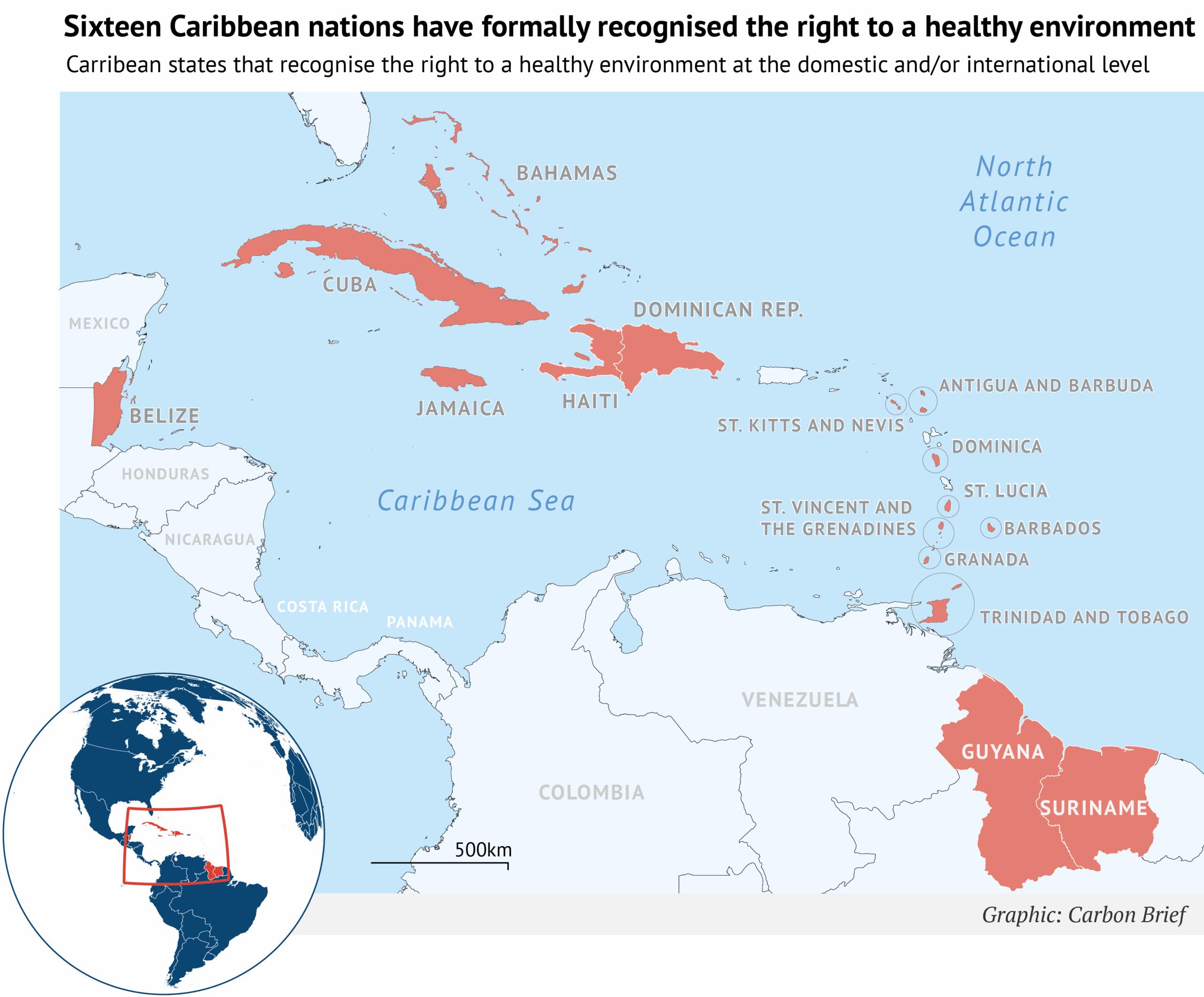
More recently, there has been a notable rise in targeted, sector-specific climate frameworks that go beyond broader environmental statutes.
Saint Lucia stands out as the only country with a climate framework law, or a comprehensive national law that outlines long-term climate strategies across multiple domains. Meanwhile, several other Caribbean governments have adopted climate-specific laws that focus on individual sectors, such as energy, migration and disaster management.
According to our analysis, more than a quarter of climate-relevant legislation in the region – comprising 21 laws and legally binding decrees – now has an explicit focus on climate change, as illustrated in the chart below.
Our research suggests that this represents an ongoing shift in legislative focus, reflecting changes in how climate legislation is being structured in one of the world’s most climate-vulnerable regions.
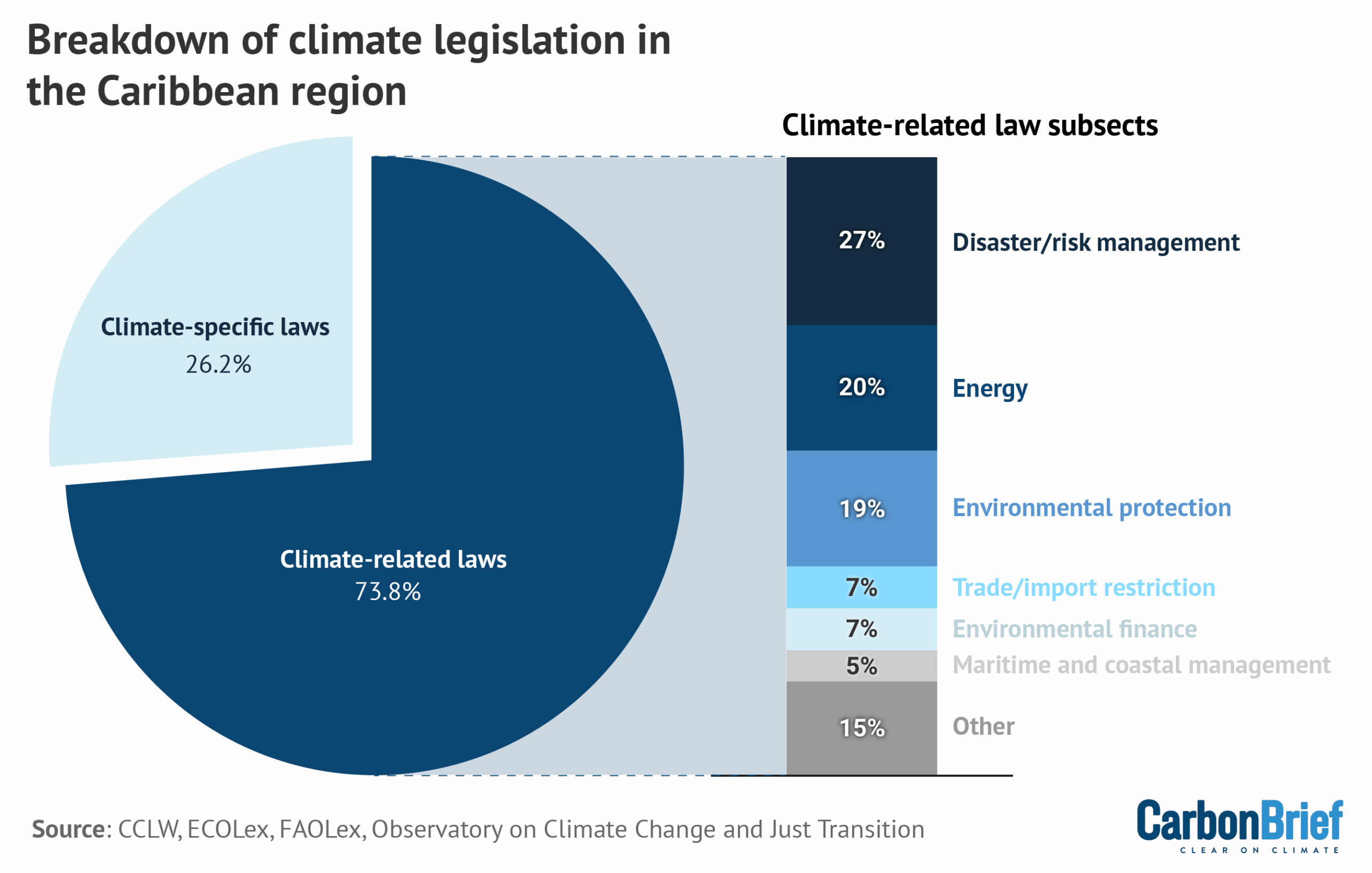
Caribbean nations are also advancing legal reforms to structure and institutionalise climate finance and market mechanisms directly into domestic law, aligned with Article 6.2 of the Paris Agreement.
For example, the Bahamas has introduced provisions for carbon credit trading, while Antigua and Barbuda, Barbados and Grenada have established national climate financing mechanisms to support mitigation and adaptation efforts.
Some states, including Belize and Saint Kitts and Nevis, have incorporated regional bodies such as the Caribbean Community Climate Change Centre – the climate arm of the intergovernmental Caribbean community organisation CARICOM – into national frameworks. This indicates an increasing alignment between regional cooperation and domestic law.
In addition to the influx of regulations specifically addressing climate change, Caribbean nations are also legislating broader environmental issues, which, in turn, could provide increased resilience from climate impacts and risks, as shown in the graph above.
Key trends in these types of climate-related laws include the expansion of disaster risk management governance, which addresses national preparedness for climate-induced weather events or related catastrophes. Likewise, energy law is an increasingly prominent focus, with countries including Antigua and Barbuda and Saint Vincent and the Grenadines integrating renewable energy and energy efficiency goals into national climate governance.
More broadly, many Caribbean nations have adopted wide-ranging and comprehensive environmental laws, many of which were developed in alignment with existing climate commitments. In combination, these legal developments reflect a dynamic and evolving climate governance landscape across the region.
Proactive vs reactive approaches
Despite general alignment with these broader regional trends, our research reveals distinct developmental pathways shaping domestic climate regulation.
In the eastern Caribbean, for example, we saw both proactive, long-term planning strategies and reactive, post-disaster reforms.
Saint Lucia’s multifaceted approach to climate resilience evolved steadily over the course of more than a decade. During this time, the country developed numerous adaptation plans, strengthened cross-sectoral coordination and engaged in institutional climate reforms in areas such as energy, tourism, finance and development.
More recently, the passage of Saint Lucia’s Climate Change Act in 2024 marked a milestone in climate governance, by giving legal force to the country’s obligations under the UNFCCC, the Kyoto Protocol and the Paris Agreement – making Saint Lucia one of the few small island states to incorporate global climate commitments into domestic law.
Our research indicates that this strategy has not only positioned the country as a more climate-resilient nation, but also solidified its access to international climate financing.
In contrast, Dominica’s efforts evolved more rapidly in the aftermath of Hurricane Maria in 2017, which destroyed over 200% of the country’s GDP. The storm’s impacts were felt across the country and hit particularly hard for the Kalinago people – the Caribbean’s last Indigenous community – highlighting the role of socioeconomic disparities in shaping climate vulnerability and resilience.
In response, the government passed the Climate Resilience Act, creating the temporary Climate Resilience Execution Agency for Dominica (CREAD).
Beyond establishing an exclusively climate-focused institution, the act aimed to embed resilience into governance by mandating the participation of vulnerable communities – including Indigenous peoples, women, older people and people with disabilities – in shaping and monitoring climate resilience projects.

As noted in a recent statement by the UN special rapporteur on Climate Change, Dr Elisa Morgera, these frameworks underscore the government’s ambition to become the world’s first “climate-resilient nation.”
Although challenges persist, Dominica’s efforts demonstrate how post-disaster urgency can drive institutional change, including the integration of rights and resilience into climate governance.
Uneven progress and structural gaps
Despite significant progress, our research shows that several key opportunities for climate governance across the Caribbean continue to exist, which could enable improvements in both resilience and long-term ambition.
The region’s legal landscape remains somewhat heterogeneous. While Saint Lucia has enacted a comprehensive climate framework law, the rest of the region lacks similar blanket legislation. This includes some states that entirely lack climate-specific laws, instead relying on related laws and frameworks to regulate and respond to climate-related risks.
Other nations have yet to adopt explicit disaster-risk management frameworks, leaving Caribbean populations vulnerable before, during and after climate emergencies. Most have yet to enshrine the right to a healthy environment at the national level.
Our research suggests that outdated legal frameworks are further limiting progress in addressing current climate risks. Because many of the longer-standing environmental laws in the region were adopted well before climate policy became a mainstream concern, some fail to address the nature, frequency and intensity of modern climate challenges, such as sea-level rise, tropical storms, wildfires, floods, droughts and other impacts.
More broadly, many Caribbean climate laws include limited integration of gender equity, Indigenous rights and social justice. As Caribbean nations such as Grenada and the Dominican Republic begin to link climate resilience with these issues, the region has an opportunity to lead by example.
Ultimately, capacity and resource constraints persist as significant barriers to implementation and adaptation.
The Caribbean region faces debt that exacerbates ongoing development challenges, a burden made heavier by the repeated economic shocks of climate-related disasters. Along with regional debt-for-resilience schemes, increased funding from high-emitting countries to support adaptation measures in climate-vulnerable nations – as endorsed under the Paris Agreement – is likely to be critical to ensuring the region’s climate laws can be executed effectively.
Global implications of Caribbean climate law
Our research suggests that Caribbean countries are outpacing other regions in terms of the scope and ambition of their climate laws. This legislation has the potential to serve as a model for climate-vulnerable nations worldwide.
Continuing efforts in the region show that legal frameworks in the field can not only drive resilience, embed rights and strengthen claims to international finance, but also highlight how regional cooperation and diplomacy can enhance global influence.
These findings demonstrate that innovation in climate law need not wait for action from major emitters, but can instead be led by those on the front lines of climate change.
The post Guest post: How Caribbean states are shifting climate legislation appeared first on Carbon Brief.
Guest post: How Caribbean states are shifting climate legislation
Greenhouse Gases
IEA: Renewables have cut fossil-fuel imports for more than 100 countries
More than 100 countries have cut their dependence on fossil-fuel imports and saved hundreds of billions of dollars by continuing to invest in renewables, according to the International Energy Agency (IEA).
It says nations such as the UK, Germany and Chile have reduced their need for imported coal and gas by around a third since 2010, mainly by building wind and solar power.
Denmark has cut its reliance on fossil-fuel imports by nearly half over the same period.
Renewable expansion allowed these nations to collectively avoid importing 700m tonnes of coal and 400bn cubic metres of gas in 2023, equivalent to around 10% of global consumption.
In doing so, the fuel-importing countries saved more than $1.3tn between 2010 and 2023 that would otherwise have been spent on fossil fuels from overseas.
Reduced reliance
The IEA’s Renewables 2025 report quantifies the benefits of renewable-energy deployment for electricity systems in fossil fuel-importing nations.
It compares recent trends in renewable expansion to an alternative “low renewable-energy source” scenario, in which this growth did not take place.
In this counterfactual, fuel-importing countries stopped building wind, solar and other non-hydropower renewable-energy projects after 2010.
In reality, the world added around 2,500 gigawatts (GW) of such projects between 2010 and 2023, according to the IEA, more than the combined electricity generating capacity of the EU and US in 2023, from all sources. Roughly 80% of this new renewable capacity was built in nations that rely on coal and gas imports to generate electricity.
The chart below shows how 31 of these countries have substantially cut their dependence on imported fossil fuels over the 13-year period, as a result of expanding their wind, solar and other renewable energy supplies. All of these countries are net importers of coal and gas.

In total, the IEA identified 107 countries that had reduced their dependence on fossil fuel imports for electricity generation, to some extent due to the deployment of renewables other than hydropower.
Of these, 38 had cut their reliance on electricity from imported coal and gas by more than 10 percentage points and eight had seen that share drop by more than 30 percentage points.
Security and resilience
The IEA stresses that renewables “inherently strengthen energy supply security”, because they generate electricity domestically, while also “improving…economic resilience” in fossil-fuel importer countries.
This is particularly true for countries with low or dwindling domestic energy resources.
The agency cites the energy crisis exacerbated by Russia’s invasion of Ukraine, which exposed EU importers to spiralling fossil-fuel prices.
Bulgaria, Romania and Finland – which have historically depended on Russian gas for electricity generation – have all brought their import reliance close to zero in recent years by building renewables.
In the UK, where there has been mounting opposition to renewables from right-wing political parties, the IEA says reliance on electricity generated with imported fossil fuels has dropped from 45% to under 25% in a decade, thanks primarily to the growth of wind and solar power.
Without these technologies, the UK would now be needing to import fossil fuels to supply nearly 60% of its electricity, the IEA says.
Other major economies, notably China and the EU, would also have had to rely on a growing share of coal and gas from overseas, if they had not expanded renewables.
As well as increasing the need for fossil-fuel imports from other countries, switching renewables for fossil fuels would require significantly higher energy usage “due to [fossil fuels’] lower conversion efficiencies”, the IEA notes. Each gigawatt-hour (GWh) of renewable power produced has avoided the need for 2-3GWh of fossil fuels, it explains.
Finally, the IEA points out that spending on renewables rather than imported fossil fuels keeps more investment in domestic economies and supports local jobs.
The post IEA: Renewables have cut fossil-fuel imports for more than 100 countries appeared first on Carbon Brief.
IEA: Renewables have cut fossil-fuel imports for more than 100 countries
-
Climate Change2 years ago
Spanish-language misinformation on renewable energy spreads online, report shows
-
Climate Change2 months ago
Guest post: Why China is still building new coal – and when it might stop
-
Climate Change Videos2 years ago
The toxic gas flares fuelling Nigeria’s climate change – BBC News
-

 Greenhouse Gases1 year ago
Greenhouse Gases1 year ago嘉宾来稿:满足中国增长的用电需求 光伏加储能“比新建煤电更实惠”
-
Greenhouse Gases2 months ago
Guest post: Why China is still building new coal – and when it might stop
-

 Climate Change1 year ago
Climate Change1 year ago嘉宾来稿:满足中国增长的用电需求 光伏加储能“比新建煤电更实惠”
-

 Carbon Footprint2 years ago
Carbon Footprint2 years agoUS SEC’s Climate Disclosure Rules Spur Renewed Interest in Carbon Credits
-
Renewable Energy3 months ago
US Grid Strain, Possible Allete Sale









